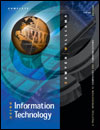 |  Using Information Technology: A Practical Introduction to Computers and Communications, 5/e Brian K. Williams
Stacey Sawyer
THE PROMISES OF THE DIGITAL AGE: Society & Information Technology Tomorrow
Web SummaryEmerging Global Communications. Two models of telecommunications
are prevalent. In the tree-and-branch telecommunications model, a centralized information provider sends out messages through many
channels to many consumers, as in many mass media. In the switched-network telecommunications model, people on the system are not only consumers of information but also
possible providers of it; this model, embodied in the Internet, is much
more participatory. Artificial Intelligence. Artificial intelligence
consists of technologies used for developing machines to emulate human qualities,
including the following: (1) Virtual reality, devices that project a person into a sensation of three-dimensional
space, is used in arcade-type games and also in simulators,
devices that represent the behavior of physical or abstract systems and
are used in training, as of airplane pilots. (2) Robotics, the development and study of machines that can perform work normally
done by people, has produced robots, automatic devices that perform functions usually performed by people.
(3) Natural language processing
is the study of ways for computers to recognize and understand human language.
(4) Fuzzy logic is a method of dealing with imprecise data and uncertainty, with problems
that have many answers rather than one. (5) Expert systems
are interactive computer programs used to solve problems normally requiring
the assistance of human experts. An expert system has three components:
a knowledge base, a database of knowledge about a particular subject; an inference engine,
the software that controls the knowledge base and produces conclusions;
and a user interface. (6) Neural networks
use physical electronic devices or software to mimic the neurological structure
of the human brain. (7) Genetic algorithms
are programs that use Darwinian principles of random mutation to improve
themselves. Artificial life
is the study of "creatures" computer instructions, or pure information
that, like live organisms, are created, replicate, evolve, and die. A-life
raises the question of how we can know when computers can be said to possess
"intelligence" or "self-awareness." One answer is suggested
by the Turing test, in which a human judge converses by means of a computer terminal with
two entities one a person, one a computer hidden in another location--to
try to determine which seems to have the most human qualities. Information & Education. The challenge of making sense of vast
stores of information is being addressed with intelligent agents,
programs that roam networks and compile data and perform work tasks on your
behalf. In education, students at all levels are finding computers helpful.
Their use in distance learning over the Internet is increasing. Health, Medicine, & Science.Telemedicine medical care
delivered via telecommunications is one way computers and communications
are changing health and medicine. The digitizing of medical information
is affecting everything from psychotherapy to implants. Patients' use of
health-care databases is changing their relationship with doctors. A new
idea in science is the "collaboratory," an Internet-based collaborative
laboratory of researchers around the world, such as that among space physicists.
In archaeology, computer technology may be used to avoid invasive excavations.
Commerce & Money. Information technology erases boundaries
in business between company departments, suppliers, and customers. Consequently,
the idea of what constitutes an organization is changing. There are new
developments in sales and marketing and retailing, as with online sales,
and in banking and cybercash, as with electronic payment systems. Entertainment & the Arts. Information technology is producing
changes in music and movies. In music, new digitized instruments offer a
wide range of sounds, while the Internet is reshaping the marketing of songs.
In movies, computers are used for all kinds of animation and other special
effects; digital equipment permits better film editing, and enables amateurs
to make movies more cheaply. Government & Electronic Democracy. The Internet has potential
for civic betterment because it is free of government intrusion, is fast
and cheap, and facilitates communication among citizens. Examples are found
in cities in California, Colorado, Texas, and Nevada. Online voting has
been tried and may be expanded. The government itself is making increasing
use of computers, as in electronic tax filing. Jobs & Careers. Job seekers can now use employer databases to
get leads on jobs, and they can post résumés with electronic
job registries so employers can find them. The five information-technology
job categories projected to have the largest percentage increase in the
near future are computer engineers, computer support specialists, systems
analysts, database administrators, and desktop publishing specialists.
|
|




 2002 McGraw-Hill Higher Education
2002 McGraw-Hill Higher Education